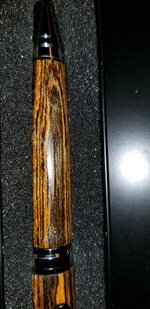MyDadsPens
Member
I have a favorite Bocote cigar pen I made two years ago, I used it once or twice a week for a year. I haven't used it in 8 or 9 months, but when I removed it from the pencase it has developed hazing and a few spots. With microscope inspection the spots are areas where the CA seems to have flaked off, all of the spots are over open grain/pore spaces. These were not there after finishing -if they were they would have filled with the buffing paste (i have plenty that do that, dam old bifocal eyes)
So anyway, just moved ALL my CA to the wife's craft room. I was using the hobby lobby brand CA, with 40% off coupons it was less than $4 a bottle.
I purchased a starter kit of Glu-Boost, I think it was more expensive than my first lathe
I would love it to be as magical as some people say, but in honesty my two biggest needs for pen finishing are
I was already at wits end with the 40% of CA pens that ghost or leave micro pores for the buffing paste, having 2 different pens ghost up after a year of use was the final straw for CA for me
I'll report my Glu boost experience here after a few pens
So anyway, just moved ALL my CA to the wife's craft room. I was using the hobby lobby brand CA, with 40% off coupons it was less than $4 a bottle.
I purchased a starter kit of Glu-Boost, I think it was more expensive than my first lathe
I would love it to be as magical as some people say, but in honesty my two biggest needs for pen finishing are
- ability to fill grain (I hate the CA and dust process, and it doesn't always work anyway)
- no ghosting or haze under the CA
I was already at wits end with the 40% of CA pens that ghost or leave micro pores for the buffing paste, having 2 different pens ghost up after a year of use was the final straw for CA for me
I'll report my Glu boost experience here after a few pens

